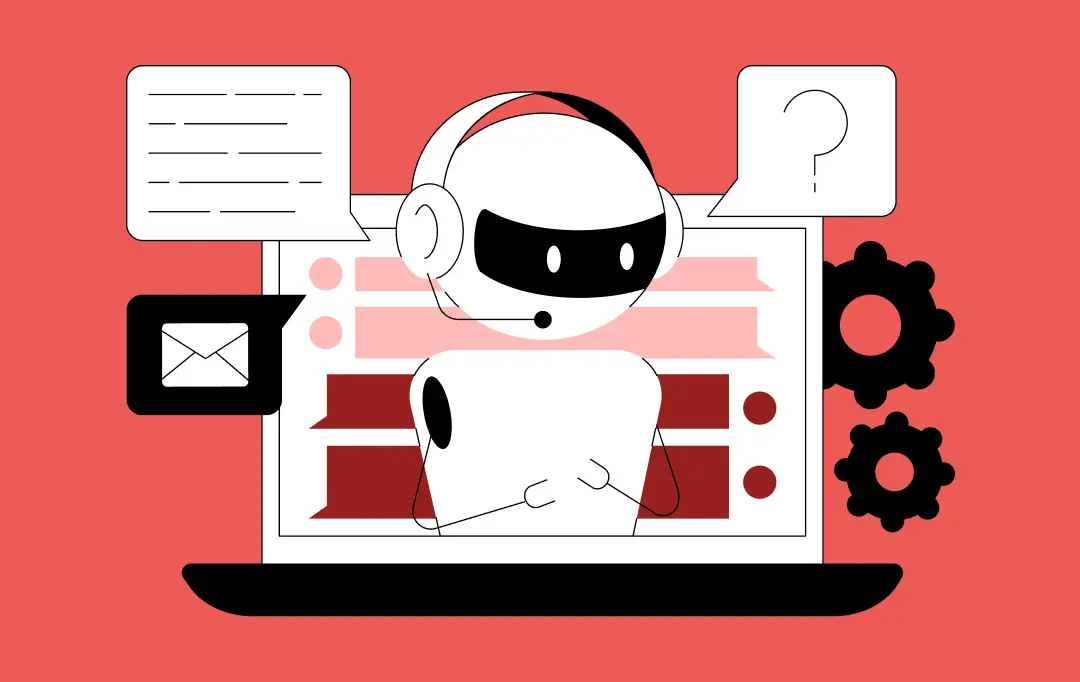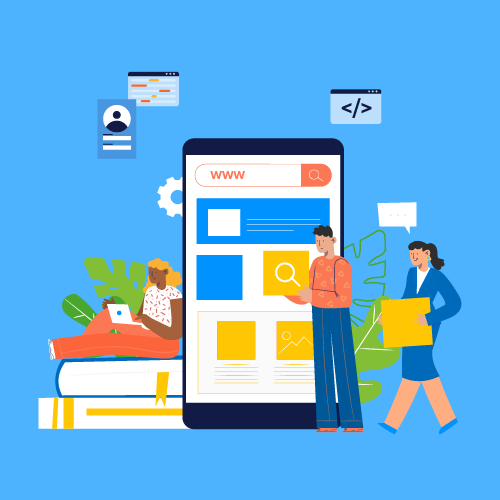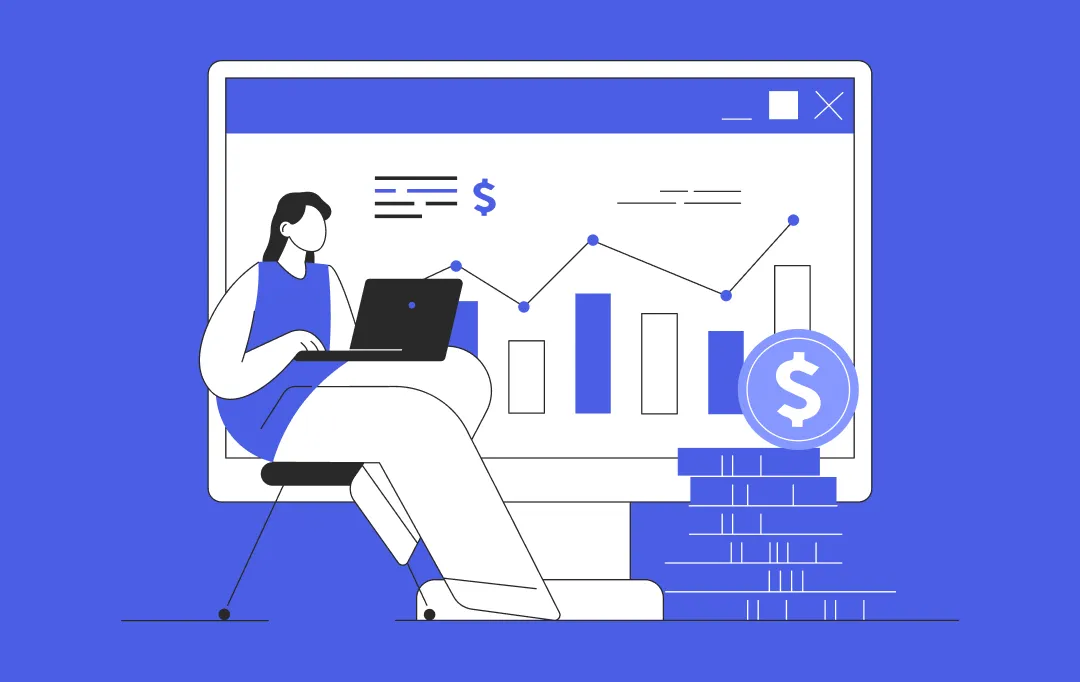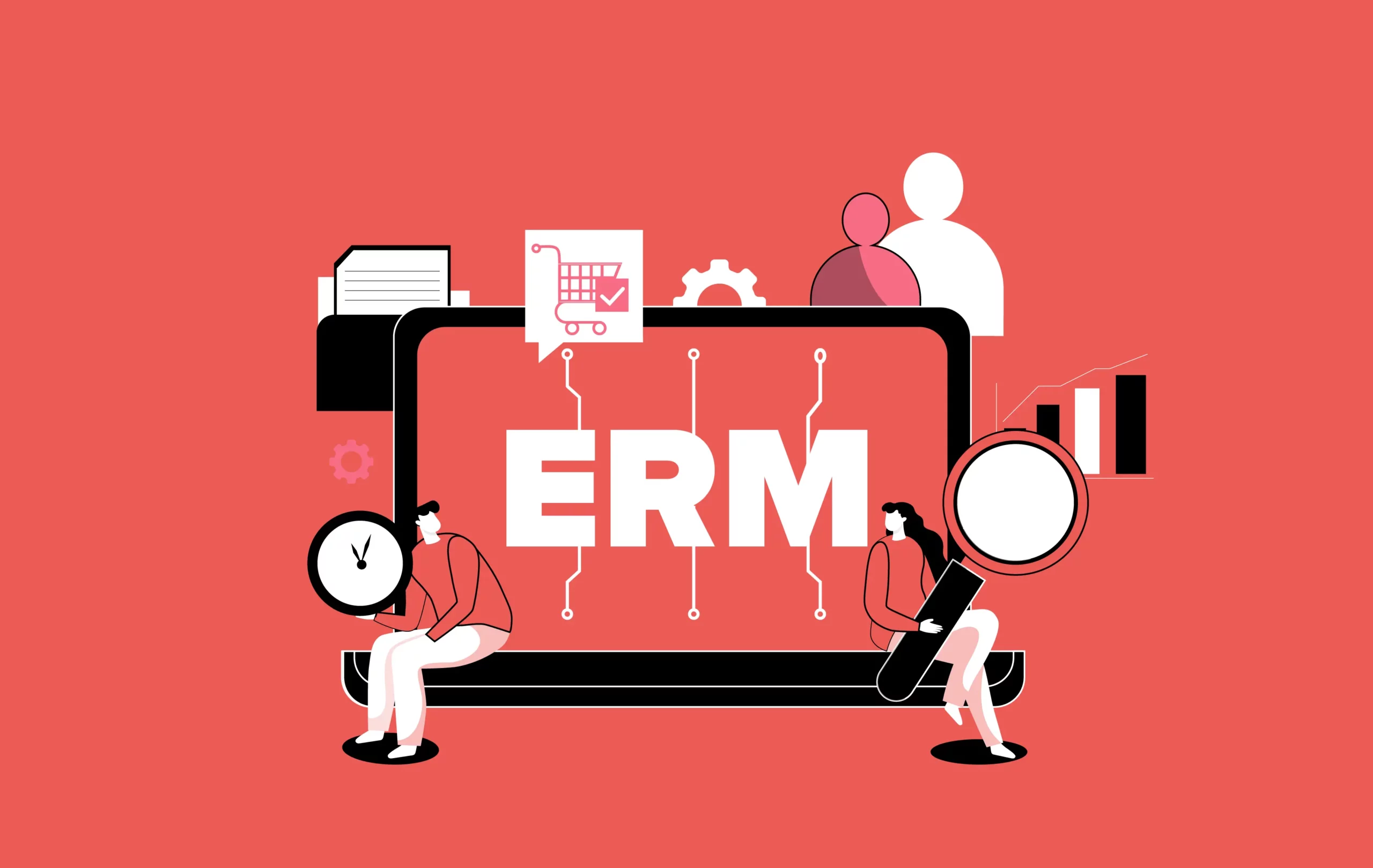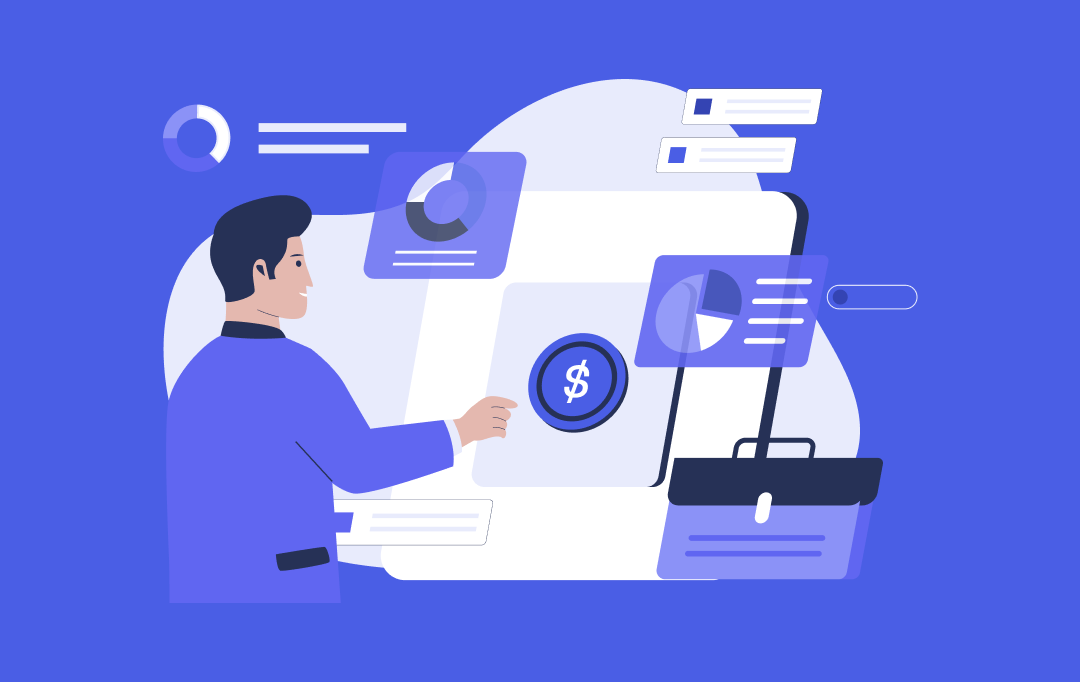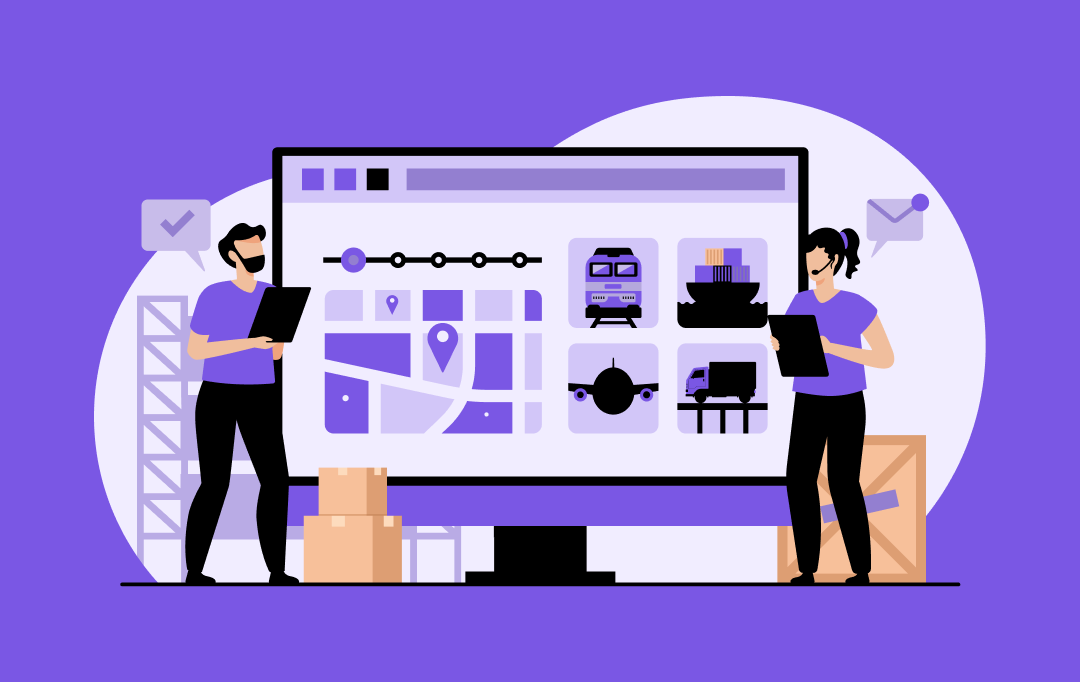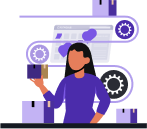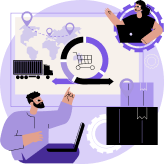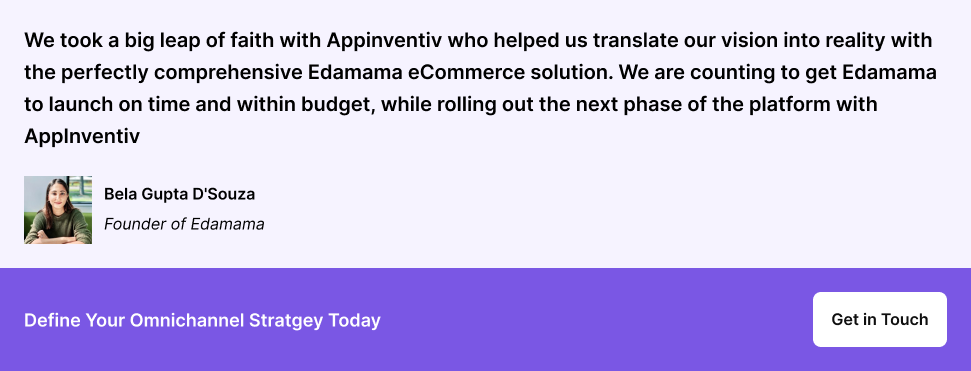- The Blueprint of Success: Steps to Build Omnichannel Fulfillment Software
- Weave the Strategy Right (Discovery)
- Choose the Right Tech Stack
- Design Intuitive UI/UX
- Develop the Software
- Connect All the Pieces
- Test to Detect Problems
- Go-Live and Grow
- Challenges in Omnichannel Fulfillment Software Development & How to Overcome Them
- Integration with Legacy Systems
- Managing Inventory Across Multiple Channels
- Handling Returns and Exchanges
- The Features & functionalities: What Should Your Software Actually Do?
- The Must-Have Features of Omnichannel Software (Your Foundation)
- The Advanced Features of Omnichannel Software (Your Competitive Edge)
- Applications and Advantages of Omnichannel Fulfillment Software
- Benefits of Omnichannel Fulfillment Software in the Real World of Retail & eCommerce
- Reduce Delivery Times and Lower Costs with Ship-from-Store
- Increase Average Order Value and Decrease Return Rates
- Improve Inventory Turnover and Customer Retention
- Reduce Order Processing Costs and Improve Accuracy
- Decrease Inventory Carrying Costs and Improve Customer Satisfaction
- What's the Cost to Develop Omnichannel Fulfillment Software?
- The Future of Omnichannel Fulfillment Software
- The Crossroads: Should You Build or Buy Omnichannel Software?
- Appinventiv: Building the Engine for Your Future Growth
- FAQs
- Unified Commerce enables your customers to see one brand, not a dozen channels. If your systems are siloed, your experience is broken.
- The whole point of this software is to get your inventory, orders, and customer data playing nice in one central system. No more guessing games.
- A custom build isn’t a weekend project. It’s a strategic journey from discovery and planning through to integration and launch.
- The cost to build omnichannel fulfillment software can go from $40,000 for a solid starting point to over $400,000 for a full-blown enterprise system. We’ll break it down.
- Build vs. Buy? Off-the-shelf works for some, but a custom solution is how you build a real competitive advantage that’s impossible to copy.
The old way of doing retail is outdated. Remember when your website and your physical store were basically two different businesses? They had their own stock, their own sales data, and they barely talked to each other. That era is dead.
Your customer doesn’t care that your eCommerce platform doesn’t sync with your in-store POS. They just know they saw a product online, drove to your store, and were told it’s “not in the system.” That’s a lost sale and a customer who probably isn’t coming back.
That friction isn’t just frustrating, it’s the difference between explosive growth and stagnation. A recent report from Shopify and EY found that retailers who have adopted unified commerce, connecting their online and offline worlds, are seeing a staggering 99% year-over-year revenue growth. Meanwhile, those still stuck with disconnected, multichannel systems? They’re only seeing 7% growth.
The market has already picked a winner; 51% of retailers have made the switch because they know disconnected systems are costing them money. They’re chasing a seamless experience because the data proves it’s the only game in town.
This is exactly where Omnichannel Fulfillment Software (OFS) steps in. Think of it less like software and more like the central nervous system for your entire retail operation. It’s the smart hub that connects every sales channel, syncs all your inventory in real-time, and figures out the smartest way to get products into your customers’ hands.
Interested in omnichannel fulfillment software development to supercharge your retail growth? Then this blog is for you. Here we will walk you through the process of development, the pitfalls, the must-have features, and what it really costs to build a system that works. So, without further ado, let’s get started:
Companies with unified systems grow revenue 99% faster than those stuck with siloed channels. Let us help you make the shift.
The Blueprint of Success: Steps to Build Omnichannel Fulfillment Software
Diving into an omnichannel order fulfillment software development project can feel massive. But it’s not magic. It’s a structured process that, when done right, turns a complex idea into a powerful operational tool. Here is a step by step process of omni-channel eCommerce fulfillment software development:
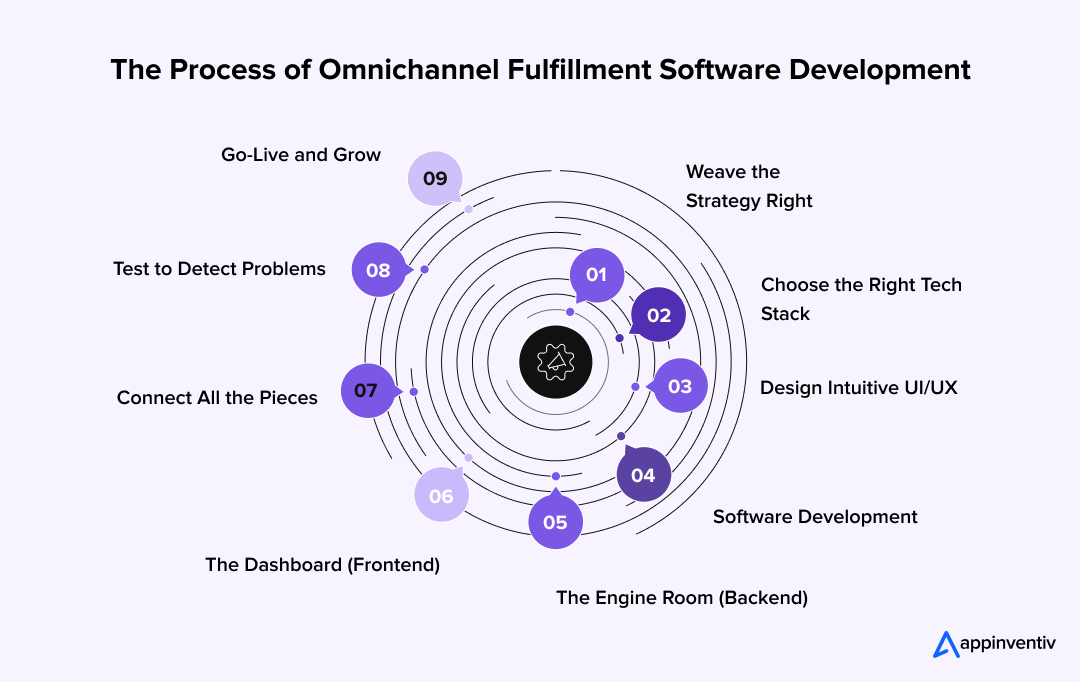
Weave the Strategy Right (Discovery)
This is where most projects are won or lost. Before you even think about code, sit down with your development team, everyone from the warehouse floor to the C-suite. Map out how you work now, find the real bottlenecks (not just the suspected ones), and define what “better” actually looks like for you. Figure out:
- What absolutely must this software do?
- Which tech stack makes sense for the long haul?
Choose the Right Tech Stack
Once you understand what you need, the next step is choosing the right technology. Think of this as picking out the right tools for a job. You need to choose the best frontend and backend systems, as well as the cloud infrastructure that will support everything.
Key technologies used in omnichannel fulfillment software development are:
| Technology | Description |
|---|---|
| Frontend Frameworks | React.js, Angular, or Vue.js for responsive and dynamic user interfaces. |
| Backend Frameworks | Node.js, Django, or Python for reliable and scalable server-side operations. |
| Database Systems | MySQL, PostgreSQL, or MongoDB for efficient data management and real-time updates. |
| Cloud Infrastructure | AWS, Microsoft Azure, or Google Cloud for scalability, uptime, and data security. |
| Integration Tools | RESTful APIs and GraphQL to connect ERP, CRM, and third-party logistics systems. |
| AI and Automation | Machine learning models for intelligent order routing and predictive analytics. |
| Security Protocols | OAuth 2.0, SSL encryption, and GDPR compliance for data protection and user privacy. |
Design Intuitive UI/UX
Your team is going to be using this platform all day, every day. If it’s clunky or confusing, adoption will fail. Thus, you must create interfaces that are clean, intuitive, and actually make your staff’s jobs easier. Focus on building interactive prototypes so your team can click around and give feedback long before the real development starts.
Develop the Software
This is where the blueprints turn into a real, working product.
- The Engine Room (Backend): This is the code that syncs inventory every few seconds, processes thousands of orders, and talks to all your other systems through APIs.
- The Dashboard (Frontend): Build the interfaces that your users will see and interact with, making sure it’s fast, responsive, and works flawlessly whether they’re on a desktop in the office or a tablet in the warehouse.
Connect All the Pieces
An omnichannel platform is useless if it’s an island. The real power comes from integration. Thus, you must build the digital bridges that connect your new software to your entire tech ecosystem:
- ERP & WMS: To keep financials, product data, and warehouse stock in perfect sync.
- eCommerce Platforms: Shopify, Magento, you name it. This helps pull orders in and push statuses out instantly.
- Shipping Carriers: This is the core of the omnichannel shipping software development piece, generating labels, tracking packages, and getting the best rates.
- POS Systems: This is something that finally merges the in-store and online worlds.
Test to Detect Problems
Before you bring your product into action, test it on several parameters. Run every kind of test imaginable, from simulating a massive traffic spike to trying to find security holes. The ultimate aim here is to find the problems so your customers don’t.
Go-Live and Grow
Once testing is done and you are sure about the software quality, you can launch it. However, launch is just the beginning. The best software needs to evolve with the changing market needs. Gather feedback, monitor performance, and continue to iterate.
This entire omnichannel fulfillment software development process is designed to give you a tool that grows with your business.
Challenges in Omnichannel Fulfillment Software Development & How to Overcome Them
Every ambitious project has its hurdles. The journey to true omnichannel operations is no different. The main challenges of omnichannel fulfillment usually boil down to wrangling old tech and siloed data into one cohesive system. Here are the major issues and the right approach to address them.
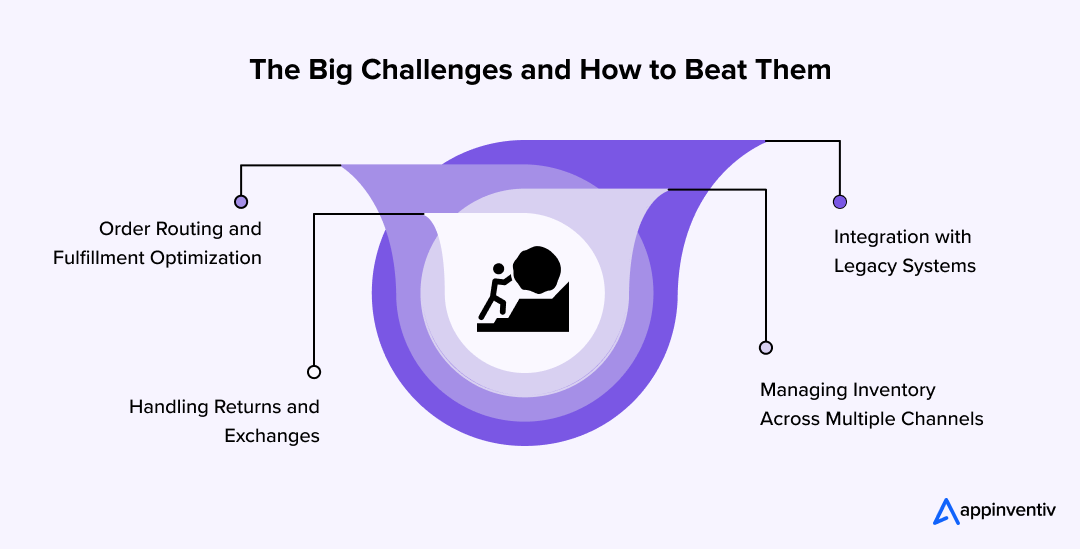
Integration with Legacy Systems
Challenge
You’ve got that ancient ERP system that everyone’s afraid to touch. It doesn’t have a modern API, and it hoards data like a dragon. This is the number one blocker when you want to build omnichannel fulfillment software.
Solution
Build a “middleware” layer. Think of it as a universal translator. This layer knows how to talk to your old system in its own language (even if that means dealing with clunky file exports) and then exposes that data through clean, modern APIs that your new platform can easily use.
Managing Inventory Across Multiple Channels
Challenge
Your website says you have 10 units, but 5 just sold in your New York store, and 2 are in a customer’s online cart. You end up overselling, which leads to angry customers and kills trust. This is the classic omnichannel e-commerce fulfillment nightmare.
Solution
You need a Centralized Inventory Management (CIM) system. This becomes your single source of truth. It constantly pings all your inventory locations (warehouses, stores, etc.) and maintains one master count of what’s actually available to sell, broadcasting it to all channels in near real-time.
Order Routing and Fulfillment Optimization
Challenge
An order comes in from a customer in Chicago. Should it ship from your main warehouse in Nevada, or the retail store just 10 miles from their house? Making this decision manually is impossible at scale.
Solution
Design a smart, rules-based Order Routing Engine. This engine uses logic you define, such as proximity to the customer, current inventory levels, store labor capacity, and shipping costs to automatically send every order to the most logical fulfillment spot.
Handling Returns and Exchanges
Challenge
The promise of “buy anywhere, return anywhere” is great marketing until a customer tries to return an online order in your store and the system can’t handle it. It’s a clunky, brand-damaging experience.
Solution
A unified Returns Management (RMA) module is the answer. It lets customers start a return online but gives your in-store staff a single view to process it. It doesn’t matter where it was bought; the system knows the order, processes the refund, and automatically updates the inventory.
The Features & functionalities: What Should Your Software Actually Do?
When you build omnichannel fulfillment software, you’re really building a toolkit for your operations team. The goal is to balance powerful functionality with ease of use. Here’s how we think about the omnichannel fulfillment software features, breaking them down into the must-haves and the game-changers.
The Must-Have Features of Omnichannel Software (Your Foundation)
These are the absolute, non-negotiable features you need to run a basic omnichannel operation.
| Feature | What It Really Means |
|---|---|
| Centralized Order Hub | One screen to see and manage every single order, whether it came from your website, Amazon, your mobile app, or a walk-in. |
| Unified Inventory View | A real-time dashboard showing every unit you own, across every warehouse and retail store. No more spreadsheets. |
| Simple Order Routing | Basic rules to get orders to the right place. For example, “All orders from California ship from the LA warehouse.” |
| Pick, Pack, Ship Tools | Digital checklists for your warehouse team, packing slip printing, and direct connections to FedEx, UPS, etc., to get labels. |
| Basic Returns (RMA) | The ability to process a return from any channel, get the product back into stock, and issue a refund. |
| Core Reporting | Simple dashboards that show you what’s selling, how fast you’re shipping, and where your inventory is. |
The Advanced Features of Omnichannel Software (Your Competitive Edge)
This is where custom omnichannel fulfillment software development really pays off, letting you build features that your competitors using off-the-shelf software can only dream of.
| Feature | What It Really Means |
|---|---|
| AI-Powered Order Routing | AI in retail engine doesn’t just follow rules, but learns. It considers shipping costs, carrier speed, and even labor availability to find the absolute cheapest and fastest way to fulfill every single order. |
| Distributed Order Management (DOM) | The brain behind complex moves like ship-from-store or BOPIS. It orchestrates the whole process to make it look effortless to the customer. |
| Predictive Forecasting | Using AI for demand forecasting to look at past sales and market trends to predict what you’re going to sell next, so you can stock up before you sell out. |
| Endless Aisle & Dropship | A store associate can sell an item that’s out of stock in their store by tapping into the entire company’s inventory and shipping it directly to the customer’s home. It’s the ultimate sale-saver. |
| Proactive Customer Comms | Automated, personalized texts and emails that keep your customer in the loop at every step, from “We got your order” to “It’s on your doorstep.” |
| Green Fulfillment | Tools that let you optimize shipping routes to cut down on mileage or offer customers a “carbon-neutral shipping” option at checkout. |
Applications and Advantages of Omnichannel Fulfillment Software
The true importance of omnichannel fulfillment software isn’t in its features, but in what those features let you do. Every use case of omnichannel fulfillment software is a direct line to a better customer experience and a healthier bottom line.
| Use Case | How It Works |
|---|---|
| Buy Online, Pick-up In-Store (BOPIS) | You slash last-mile delivery costs (which are huge) and you get customers to walk into your store, where they often buy more. The software handles the whole workflow, from telling the store to pick the order to texting the customer that it’s ready. |
| Ship-from-Store | This turns your stores into mini-warehouses. Instead of that shirt gathering dust on a rack in Miami, you can use it to fulfill an online order from someone in Fort Lauderdale. This moves inventory faster, reduces markdowns, and offers crazy-fast local delivery. It’s a core tactic for modern omnichannel ecommerce fulfillment. |
| Endless Aisle | A customer in your store wants a shoe in size 9, but you only have a10. In the old days, that was a lost sale. Now, your employee pulls out a tablet, finds the size 9 in another store or warehouse, and ships it directly to their house. Sale saved. |
| Seamless Returns | The customer buys a dress online but returns it to their local store. Your employee scans the receipt, the system instantly recognizes the order, and the refund is processed. This easy experience builds massive trust and loyalty. |
A great example of omnichannel fulfillment software in the wild is what big retailers like Target have built. Their app is a masterclass in this: it tells you an item’s exact aisle location, lets you order for pickup, and can ship from your local store.
That’s not magic; it’s a world-class fulfillment system powering every click and every step. This powerful use case of omnichannel fulfillment software is what makes the experience feel so connected.
Also Read: How Much Does It Cost to Develop A Shopping App Like Target
Benefits of Omnichannel Fulfillment Software in the Real World of Retail & eCommerce
Omnichannel fulfillment software is a game-changer for businesses that wish to streamline operations and enhance customer experience. Let’s explore how implementing omnichannel fulfillment can drive measurable benefits for your business.
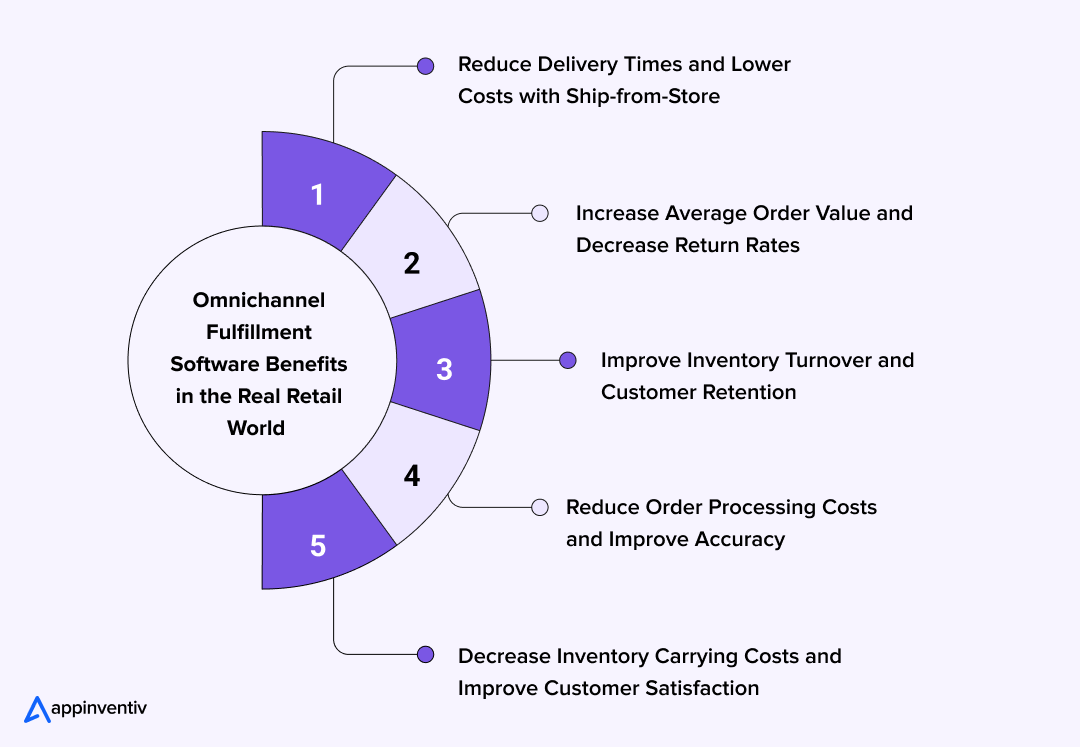
Reduce Delivery Times and Lower Costs with Ship-from-Store
Large retail chains implement unified fulfillment, enabling ship-from-store capabilities. Orders route to stores nearest to customers, rather than always fulfilling from central warehouses. Stores utilize excess inventory for online orders during slower traffic periods.
Benefit:
- Delivery time reductions as average shipping distances decrease significantly.
- Shipping costs are lower through reduced zone charges and dimensional weight fees.
- Store inventory productivity improves by monetizing previously idle stock.
- Customer satisfaction increases as faster delivery meets rising expectations.
Increase Average Order Value and Decrease Return Rates
Digital-native brands open physical showrooms to complement their established e-commerce operations. Unified fulfillment systems allow customers to browse products in showrooms, complete purchases seamlessly, and choose home delivery or pickup options. Store inventory supports both walk-in sales and online order fulfillment.
Benefit:
- Higher average order values show that customers who interact with products physically before purchasing tend to spend more.
- Return rates decrease as customers make more informed purchase decisions.
- Store operations become profitable faster by serving dual sales and fulfillment purposes.
Improve Inventory Turnover and Customer Retention
Grocery retailers implement omnichannel fulfillment, supporting online ordering with store pickup and delivery. Real-time inventory ensures accurate availability information for perishable items with limited shelf life. Temperature-controlled fulfillment maintains product quality throughout the last mile.
Benefit:
- Grocery retailers see online channels growing to represent a significant portion of total revenue within 18-24 months.
- Customer retention improves with increased shopping frequency due to convenient fulfillment options.
- Shrinkage decreases as better inventory visibility and faster turnover of perishable items are achieved.
Reduce Order Processing Costs and Improve Accuracy
Industrial parts suppliers modernize fulfillment infrastructure to support both B2B customers and newly launched B2C e-commerce. Complex order scenarios include partial shipments, backorder management, and customer-specific pricing.
Benefit:
- Order processing costs are reduced significantly through automation, replacing manual entry and phone-based ordering.
- Order accuracy improves as electronic ordering eliminates transcription errors.
- Customer acquisition expands as eCommerce channels allow businesses to reach smaller buyers previously uneconomical to serve through field sales.
Decrease Inventory Carrying Costs and Improve Customer Satisfaction
Fashion brands use omnichannel fulfillment to manage seasonal merchandise transitions. Automated transfer orders redistribute slow-moving inventory from underperforming stores to high-demand locations.
Benefit:
- End-of-season markdowns decrease when inventory reaches optimal markets before aggressive discounting is necessary.
- Inventory carrying costs decline through improved turnover.
- Customer satisfaction increases as popular items remain in stock through intelligent redistribution, which improves profitability.
Build a robust, scalable omnichannel fulfillment solution with our expert team and stop losing sales.
What’s the Cost to Develop Omnichannel Fulfillment Software?
The cost to develop omnichannel fulfillment software isn’t a simple, one-size-fits-all number. It depends entirely on how complex your vision is. However, to help you get an average figure, we can break it down into realistic tiers.
- The MVP Development: $40,000 – $100,000
MVP development gets you the essentials: centralized orders from a couple of channels (like your website and Amazon), unified inventory, and basic shipping integrations. It’s the perfect starting point to get your house in order.
- The Custom Powerhouse: $100,000 – $200,000
Here, you build the foundation with advanced tools. This is where you get your ship-from-store and BOPIS logic, connect to more complex systems like your ERP, and build a smarter order routing engine.
- The Enterprise Game-Changer: $200,000 – $400,000
This is for large-scale operations that need it all: AI-powered forecasting, endless aisle, complex international omnichannel shipping software development, and deep, advanced AI analytics. This is a system built to be a core competitive advantage.
The final cost of software development for omnichannel fulfillment also depends on the team you work with. A dedicated development team from a partner like Appinventiv gives you a realistic budget and timeline, which is often more practical in the long run than trying to piece it together with freelancers or an in-house team.
The Future of Omnichannel Fulfillment Software
This space is moving fast. The omnichannel systems we’re building today are just the beginning. Here’s a quick peek at what’s coming next:
Hyper-Personalization: Imagine a system that knows a customer prefers morning deliveries or eco-friendly packaging and automatically selects those options. Sounds compelling? Well, that’s where we’re headed.
Robots in the Warehouse: Automation is getting advanced with each passing day. Your OFS will be the “brain” that directs fleets of robots to pick and pack orders with incredible speed and accuracy.
Sustainability by Default: Soon, tracking the carbon footprint of every order will be the new norm. Your software will help you make greener choices and let your customers see the impact.
Smarter Supply Chains (IoT): Tiny sensors on everything from pallets to products will give you a level of real-time tracking we’ve never seen before, and your OFS will use that data to predict and prevent delays.
The Crossroads: Should You Build or Buy Omnichannel Software?
This is the million-dollar question. Do you license a pre-built SaaS tool or invest in a custom omnichannel order fulfillment software development project? There’s no single right answer, but here’s how you can make the right choice:
When to “Buy”
Off-the-shelf platforms are great if your needs are fairly standard.
- You need it fast. You can be up and running in weeks.
- Your budget is tight upfront. It’s a predictable monthly fee instead of a big capital investment.
- Your process is flexible. You’re willing to adapt your workflow to fit the software’s pre-built logic.
When to “Build”
Building custom software is a strategic move for businesses that see their operations as a competitive weapon.
- Your process is unique. You have a specific “secret sauce” for how you run things, and no off-the-shelf tool can replicate it.
- You want to own the experience. A custom build lets you create unique fulfillment options that nobody else can offer.
- You need to scale without limits. A custom system grows with you. You’re never stuck waiting for a software vendor to add a feature you desperately need.
- You want to own your data. With a custom build, the code is yours, the data is yours. You control everything.
The decision to build omnichannel fulfillment software is more than just a tech project; it’s an investment in a long-term business asset that you control completely.
Appinventiv: Building the Engine for Your Future Growth
Moving from a clunky, multichannel mess to a smooth omnichannel machine is the single biggest operational upgrade you can make in today’s market. It’s how you win. Your omnichannel fulfillment software is the engine that drives that transformation, turning your logistics from a simple cost center into a powerful tool for delighting customers.
But embarking on the journey of the omnichannel fulfillment software development requires more than just great coders. It requires a tech partner who gets the retail world, its pressures, its complexities, and its opportunities.
Here at Appinventiv, this is what we do. We don’t just build software; we architect custom operational systems that solve real-world problems that your business faces every day.
In our 10+ years of industry experience, we have delivered over 3000+ successful projects, including 400+ eCommerce platforms, earning a 96% client satisfaction rate. Our expertise spans multiple channels, ensuring your omnichannel fulfillment system isn’t just functional but future-proof.
We have worked with over 30+ retailers and brands, transforming their eCommerce operations into smooth, high-performance machines that meet modern consumer demands.
Our team of 1600+ tech experts possesses deep industry knowledge with advanced technology to deliver solutions that are not just functional but also adaptable to future challenges. Whether you’re looking to streamline your inventory management with the power of AI, optimize order routing, or create a frictionless return system, we know how to make it happen.
Don’t just believe in our words or numbers, peep into some of our retail projects to witness how we help our clients turn their vision into reality:
IKEA
We developed an award-winning ERP solution for IKEA, enhancing in-store customer experiences and providing real-time product information.
The impact?
- 7+ IKEA Stores adopted the ERP system.
- Improved marketing efficiency and customer engagement
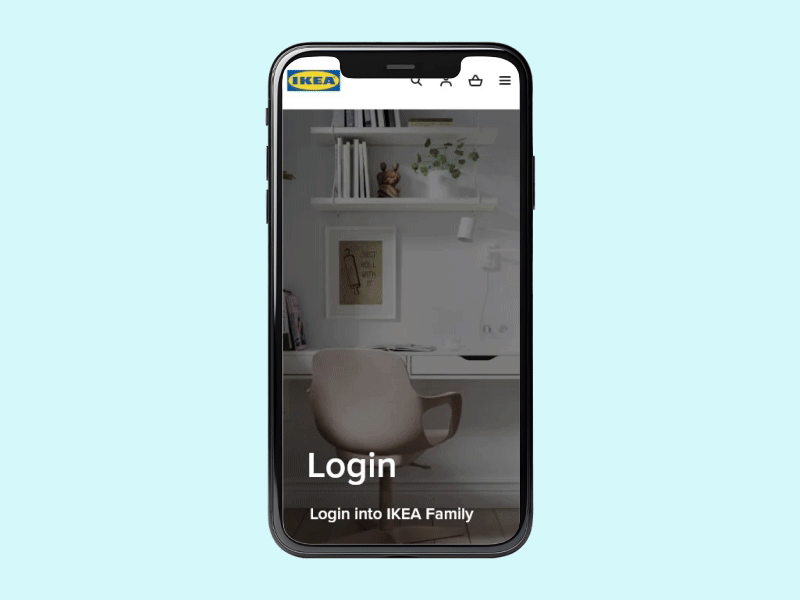
Adidas
We launched a dedicated, intuitive eCommerce app for Adidas, enriching the shopping experience and amplifying reach among sports enthusiasts.
The impact?
- 2 Million Downloads.
- 500K New Users Acquired
Edamama
We collaborated with Edamama to create a dynamic eCommerce platform tailored for mothers, incorporating personalized recommendations and real-time tracking.
The impact?
- $5 Million Funding Raised.
- 100,000 Expecting and New Mothers Served
6th Street
We developed a user-friendly fashion platform for 6th Street, integrating payment gateways, push notifications and various other features.
The impact?
- 3+ Million Downloads on iOS.
- 1+ Million Downloads on Android
If the success of these leading retail brands inspires you, don’t delay any longer. Contact us now and see how our software development services can help you build an omnichannel fulfillment software product or something similar you desire.
Partner with us now and build a fulfillment engine that powers your future growth.
FAQs
Q. What is omnichannel fulfillment?
A. Omnichannel fulfillment means all your sales channels, your website, your stores, your app, work together as one system. A customer can buy online and pick up in-store, or return an online order to a physical location, and the system handles it all seamlessly.
Q. What’s the difference between multichannel and omnichannel fulfillment?
A. Multichannel fulfillment treats each sales channel as an independent operation with separate inventory pools, distinct fulfillment processes, and isolated customer data. Customers purchasing online cannot easily return items in stores.
Omnichannel fulfillment eliminates these silos, creating unified inventory visibility and flexible fulfillment options regardless of where customers initiate purchases.
The core difference between multichannel and omnichannel fulfillment software lies in integration: multichannel operates channels independently while omnichannel unifies them into cohesive systems.
Q. How much does it cost to build omnichannel fulfillment software?
A. It’s a wide range. Typically, the cost to build omnichannel fulfillment software ranges between $40,000 and $400,000 or more.
Contact us to get a more precise estimate for omnichannel fulfillment software development.
Q. Is omnichannel fulfillment right for your business?
A. The benefits of omnichannel fulfillment software are huge: you sell more, make customers happier, and run your operations way more efficiently. So, if you sell in more than one place (like online and in-store) and you care about customer loyalty, then yes, absolutely, omnichannel fulfillment is right for your business
Q. Why do businesses need omnichannel fulfillment software?
A. You need it because your customers already expect it. They don’t see your business as a website and a store; they see it as one brand. This software is the technology that lets you operate that way, making sure you have the right product in the right place at the right time. It’s the key to stopping lost sales and keeping customers coming back.


- In just 2 mins you will get a response
- Your idea is 100% protected by our Non Disclosure Agreement.
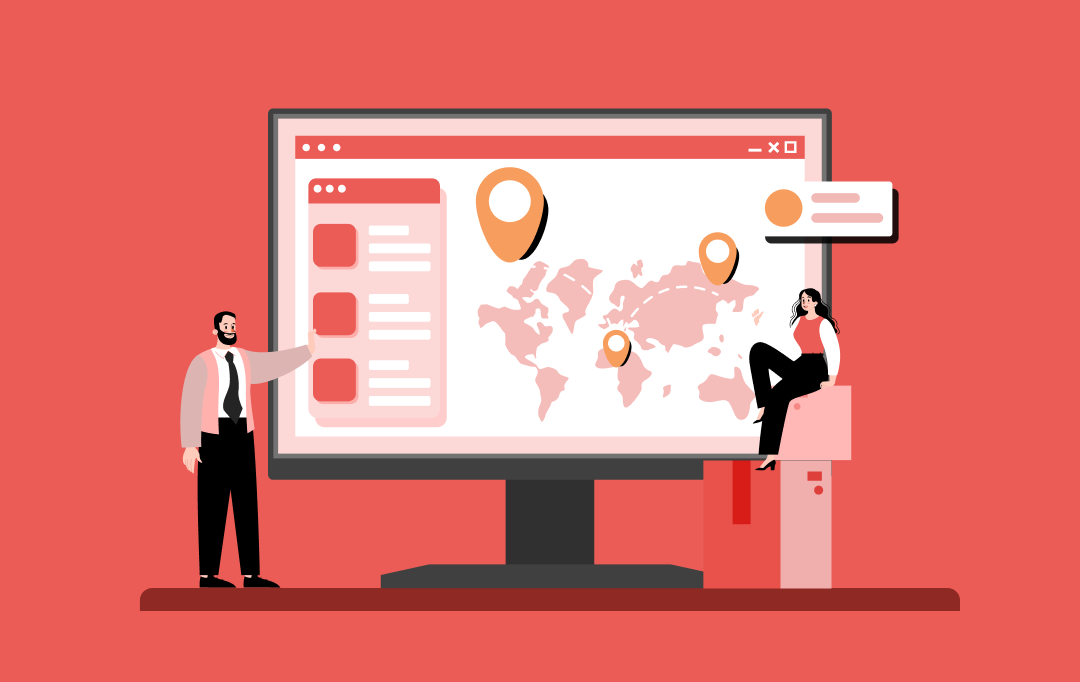
The Real Cost of Building Professional Delivery Management Software
Key takeaways: Custom delivery management software has complete flexibility, scale, and integration, which conforms to the distinctive requirements of business. Fluid connection to ERP, CRM, and payment systems also introduces a large amount of complexity and additional cost, but is the key to efficiency. It is important to design scalable systems to grow in the…
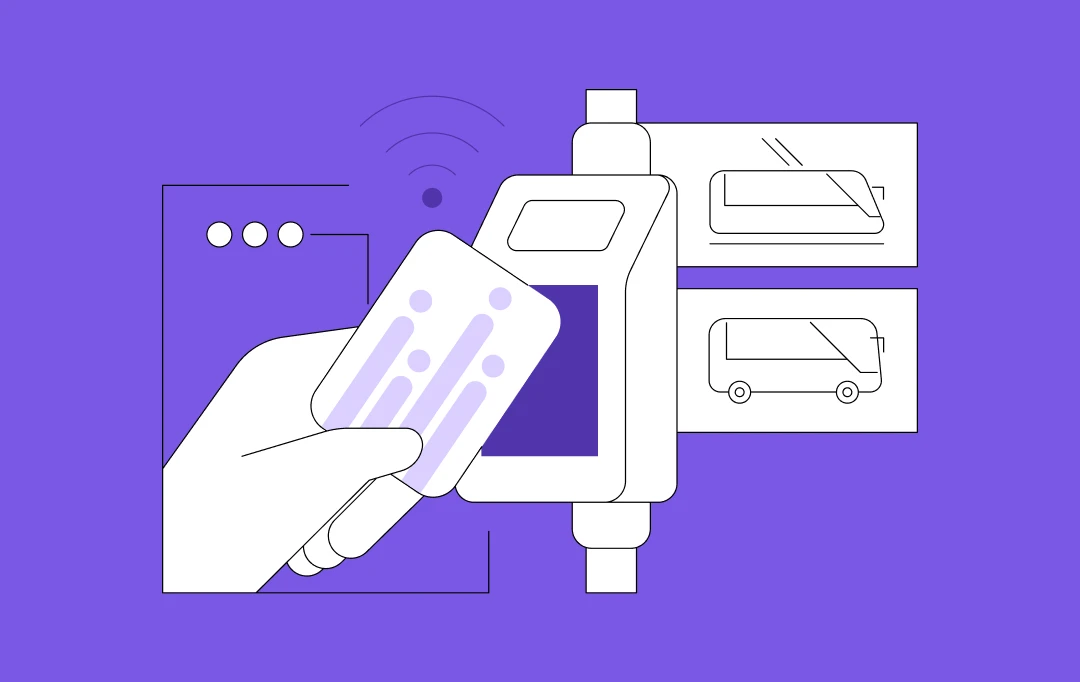
How to Build an RFID Asset Tracking System in The UAE?
Key takeaways: The success of an RFID asset tracking system is dictated by the quality of the custom software and middleware, which must transform voluminous raw tag data into actionable intelligence. Implementation of RFID systems requires a managed, multi-stage process, moving logically from Integration Consulting and architectural design to Continuous Monitoring and Optimization, which is…
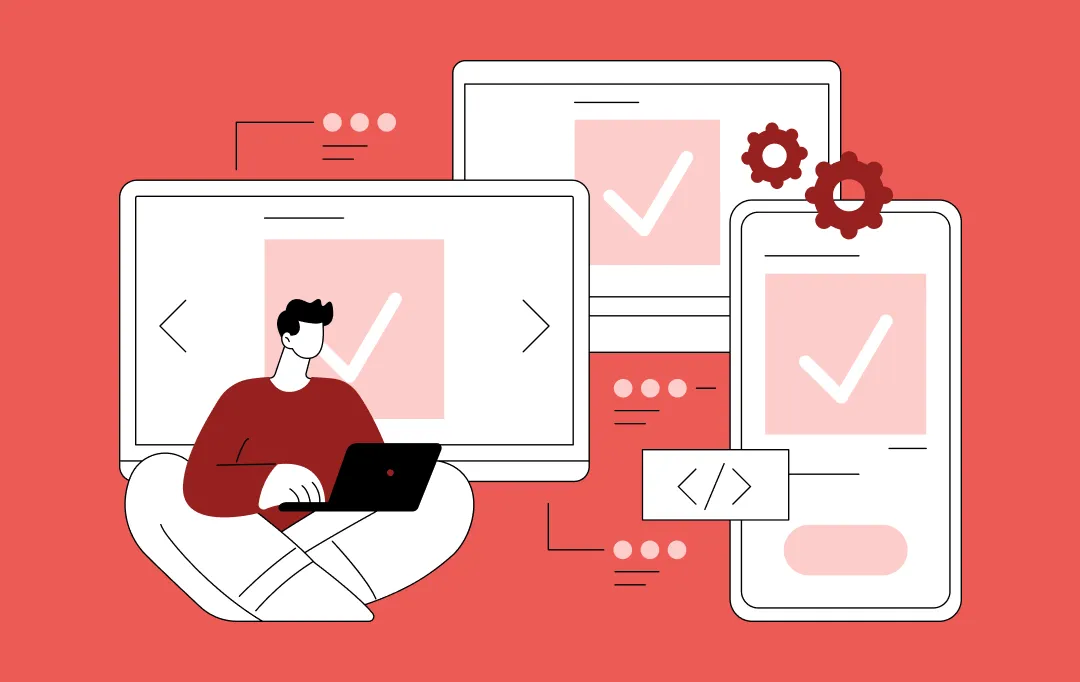
How to Build a White-Label Grievance Management Software? Process, features, costs
Key Takeaways White-label grievance management software allows businesses to quickly implement, rebrand, and scale solutions without reinventing the wheel. The development process involves multiple stages, including requirement gathering, workflow design, tech stack selection, and ensuring compliance and scalability. Key features include multi-channel intake, automated routing, customizable workflows, AI-driven categorization, and built-in compliance and security. Costs…











